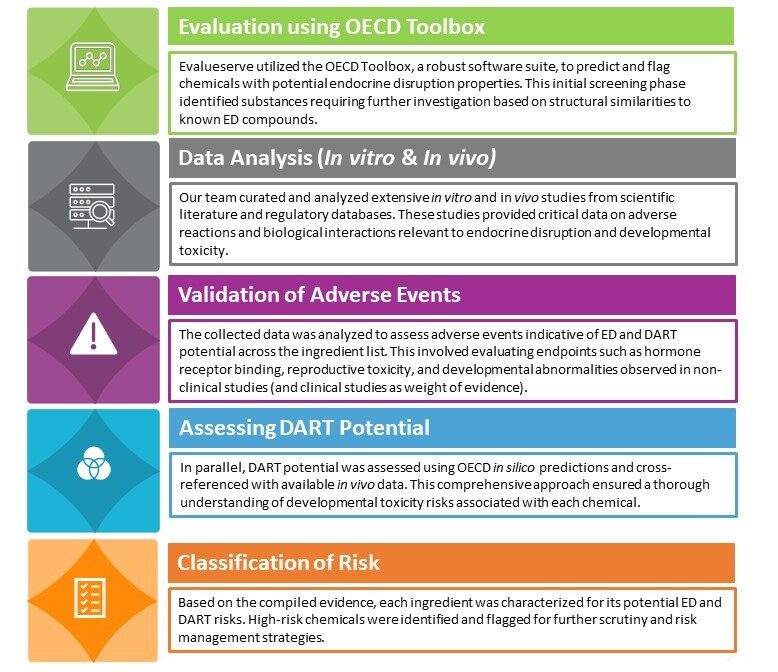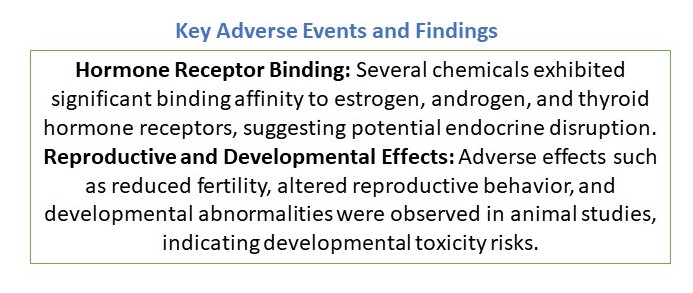Are Everyday Chemicals Silently Disrupting Our Hormones?
In a world increasingly dominated by synthetic chemicals, one pressing question remains: How are these substances affecting our health and the environment? Endocrine disruptors, a class of chemicals found in everything from plastics to personal care products, are at the heart of this concern. These insidious compounds can interfere with hormone systems, leading to a cascade of health issues such as reproductive disorders, developmental problems, and even cancers.
At Evalueserve, we understand the critical importance of identifying and mitigating the risks posed by endocrine disruptors. As a leading provider of toxicology consulting services, our team of experienced toxicologists, pharmacologists, data scientists, and regulatory experts is dedicated to helping businesses navigate the complex regulatory landscapes and ensure compliance with the latest safety standards. Our comprehensive approach combines cutting-edge research with practical solutions to safeguard public health and environmental sustainability.
Understanding and mitigating the effects of endocrine disruptors is not just a regulatory necessity—it’s a scientific imperative. The widespread impact of these chemicals demands rigorous assessment and innovative management strategies. By leveraging our expertise, Evalueserve is at the forefront of this crucial effort, providing invaluable support to organizations committed to making a positive difference.
What Are Endocrine Disruptors?
Understanding Endocrine Disruptors: The Hidden Hazards in Everyday Life
Endocrine disruptors are chemicals that can interfere with humans and wildlife’s endocrine (or hormone) systems. These systems regulate critical bodily functions, including growth, metabolism, and reproduction. When endocrine disruptors enter the body, they can mimic or block natural hormones, leading to various health issues.
Sources of Endocrine Disruptors
Endocrine disruptors can be found in various everyday products and environmental sources. Some common examples include:
- Plastics and Canned Goods: Bisphenol A (BPA), often found in plastic containers and the linings of canned foods, is a well-known endocrine disruptor.
- Personal Care Products: Phthalates, used in many cosmetics and personal care items, such as shampoos and lotions, can disrupt hormone function.
- Pesticides: Certain pesticides, such as DDT and glyphosate, have been shown to interfere with the endocrine system.
- Industrial Chemicals: Polychlorinated biphenyls (PCBs) and dioxins, by-products of industrial processes, are potent endocrine disruptors.
- Flame Retardants: Chemicals like polybrominated diphenyl ethers (PBDEs), used in furniture and electronics, can also affect hormonal balance.
The Widespread Nature of Endocrine Disruptors
Endocrine disruptors are pervasive in our environment, making their way into the air we breathe, the water we drink, and the food we eat. This widespread exposure poses significant risks to public health. Here are some critical implications:
- Reproductive Health: Exposure to endocrine disruptors has been linked to reduced fertility, developmental abnormalities in children, and altered sexual development.
- Developmental Issues: These chemicals can interfere with the growth and development of children, leading to learning disabilities, behavioral problems, and other long-term health issues.
- Hormone-Related Cancers: Certain endocrine disruptors are associated with an increased risk of cancers such as breast, prostate, and thyroid cancer.
- Metabolic Disorders: Disruptions in hormonal balance can contribute to obesity, diabetes, and other metabolic conditions.
Given the ubiquitous presence of endocrine disruptors and their profound impact on health, individuals, businesses, and policymakers must take proactive steps to mitigate these risks. At Evalueserve IP and R&D, we are committed to providing the expertise and resources necessary to identify and manage endocrine disruptors effectively, ensuring safer products and a healthier environment for all.
Understanding the nature and sources of endocrine disruptors is the first step toward protecting public health and the environment. By raising awareness and promoting informed actions, we can collectively address this hidden hazard and foster a safer, healthier future.
Breaking Down Barriers – Regulatory Frameworks for Endocrine Disruptors
EPA Framework: Safeguarding Health with Rigorous Standards
The Environmental Protection Agency (EPA) leads the charge in regulating endocrine disruptors in the United States through several key initiatives:
- Endocrine Disruptor Screening Program (EDSP): This two-tiered program screens and tests chemicals for endocrine-disrupting potential.
- Tier 1 Screening: Identifies substances with possible endocrine effects.
- Tier 2 Testing: Confirms and details these effects.
- The Toxic Substances Control Act (TSCA) evaluates and regulates chemicals, ensuring their safety regarding endocrine disruption.
- Pesticide Registration: Requires rigorous testing of pesticides for endocrine-disrupting properties before they hit the market.
The EPA’s framework ensures comprehensive assessment and regulation of endocrine disruptors, protecting public health and the environment.
OECD Framework: Setting Global Standards for Safety
The Organization for Economic Co-operation and Development (OECD) promotes international consistency in endocrine disruptor testing and regulation:
- OECD Test Guidelines: The OECD has developed standardized test guidelines for identifying endocrine-disrupting chemicals. These guidelines cover various aspects of endocrine disruption, including effects on estrogen, androgen, and thyroid hormone systems.
- Adverse Outcome Pathways (AOPs): The OECD promotes using AOPs, which describe the progression from a molecular-level perturbation to an adverse health outcome. AOPs provide a structured way to understand and assess the effects of endocrine disruptors.
Navigating the regulatory landscape of endocrine disruptors requires expertise in both EPA and OECD frameworks. At Evalueserve, we offer the knowledge and experience to help businesses achieve compliance and ensure safety. Together, we can tackle the challenges of endocrine disruptors and contribute to a healthier future.
Case study – Assessing Endocrine Disruption and Developmental Toxicity Potential in Fragrances & Flavor Materials
Fragrances and flavor materials play a vital role in enhancing consumer products. Yet, the chemical complexity of these ingredients can harbor potential risks, including endocrine disruption (ED) and developmental toxicity (DART). Evalueserve undertook a comprehensive assessment for a USA-based personal care product manufacturer, aiming to evaluate and mitigate these risks across a diverse portfolio of over 350 chemical ingredients involved in fragrances in personal care products.
Our approach included:


Our assessment concluded with actionable recommendations, including risk mitigation strategies by enhanced monitoring of ED and DART endpoints in further research and substitution of high-risk chemicals. All the ED conclusions were provided based on regulatory compliance and ensuring alignment with global standards and regulatory requirements concerning ED and DART frameworks.
Looking Ahead: Navigating Regulatory Compliance with Ease
Complying with regulatory requirements related to endocrine disruptors can be daunting for businesses. However, you can navigate this complex landscape smoothly with the right strategies and support. Here are some practical tips to help your business stay on top of regulatory demands:
- Stay Informed and Updated
Regulations around endocrine disruptors are continually evolving. Ensure you keep abreast of the latest guidelines and standards set by agencies like the Environmental Protection Agency (EPA) and the Organization for Economic Co-operation and Development (OECD). To stay informed, subscribe to regulatory newsletters, attend industry webinars, and participate in relevant forums. Our team at Evalueserve actively engages in collaborative research initiatives and industry forums to drive advancements in the field.
- Implement a Robust Screening Program & Conducting Comprehensive Risk Assessments
Utilize advanced tools to screen your chemical ingredients for potential endocrine-disrupting properties. This software suite can help predict and flag chemicals that may require further investigation, saving you time and resources in the long run. Invest in thorough In vitro and In vivo studies to understand your products’ endocrine and developmental toxicity potential. Evalueserve can assist in curating and analyzing scientific literature and regulatory data, providing a clear picture of any risks associated with your ingredients.
- Prioritize High-Risk Chemicals
Focus your efforts on identifying and mitigating high-risk chemicals in your product portfolio. Develop strategies for reformulation or substitution where necessary to minimize potential health impacts and ensure regulatory compliance. Our team continuously explores and integrates cutting-edge technologies and methodologies to provide the most accurate and efficient assessments.
- Develop a Compliance Roadmap
Create a clear and actionable compliance roadmap tailored to your business needs. This should outline steps for aligning your products with current and upcoming regulatory standards, including necessary testing, documentation, and reporting requirements. We at Evalueserve understand that each business is unique. Our team offers personalized solutions that address your specific regulatory and safety needs.
Engage with Us
In this blog, we have explored the complexities of endocrine disruptors, including their sources, impacts, and the regulatory frameworks governing them. We have also shared practical tips for businesses to navigate these challenges and highlighted future trends in this dynamic field.
Evalueserve’s IP and R&D expertise in toxicology consulting is your key to successfully managing the risks associated with endocrine disruptors. Our innovative approaches and personalized solutions ensure you stay compliant and ahead of the curve.
Don’t hesitate to ask for more information or explore potential collaborations. Together, we can safeguard public health and drive sustainable growth in your business.
We invite you to engage with our team for tailored toxicology consulting services. Whether you need assistance with risk assessments, regulatory compliance, or strategic planning, Evalueserve supports you.
Don’t miss important updates, industry news, and expert insights.
Talk to One of Our Experts
Ready to safeguard your products and ensure compliance with the latest safety standards?


